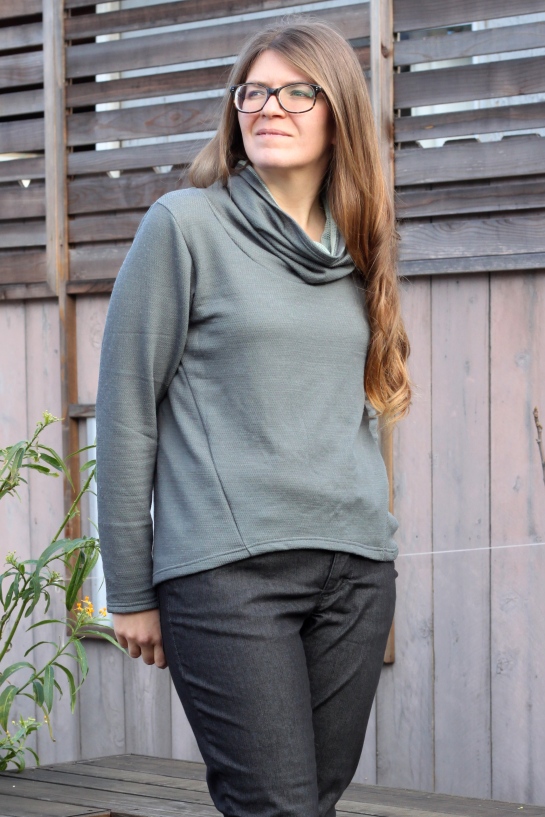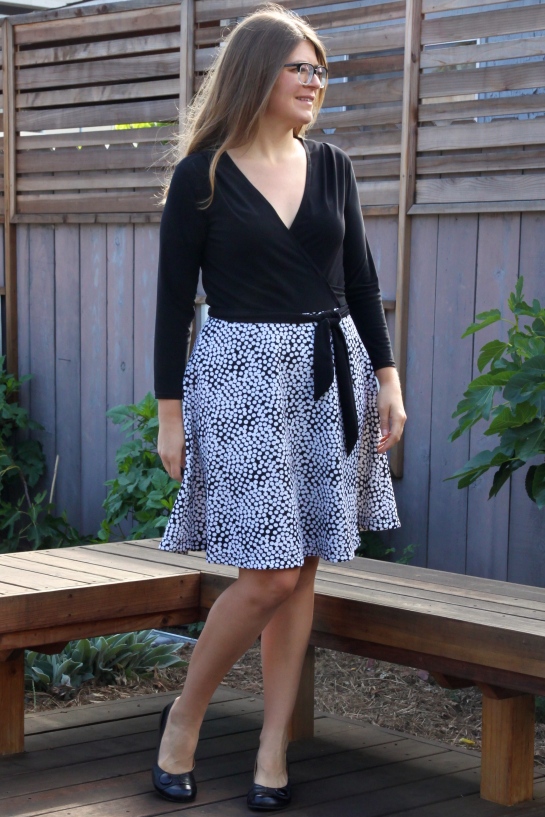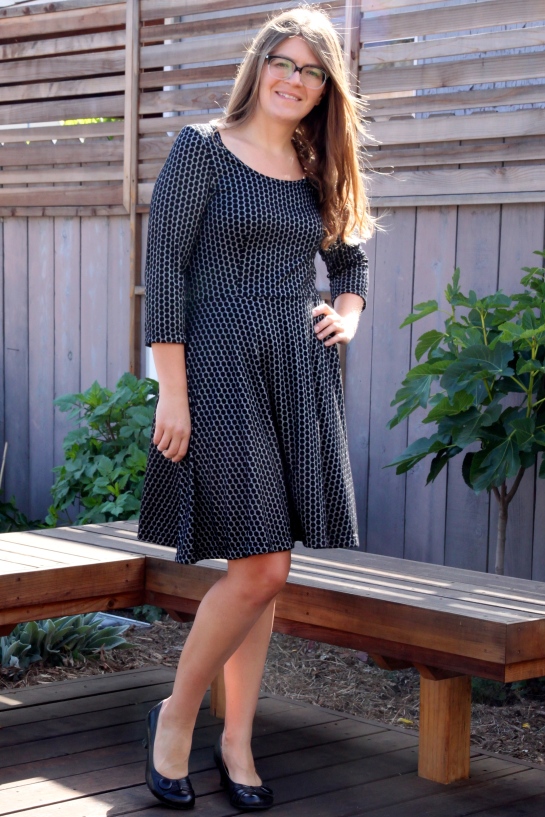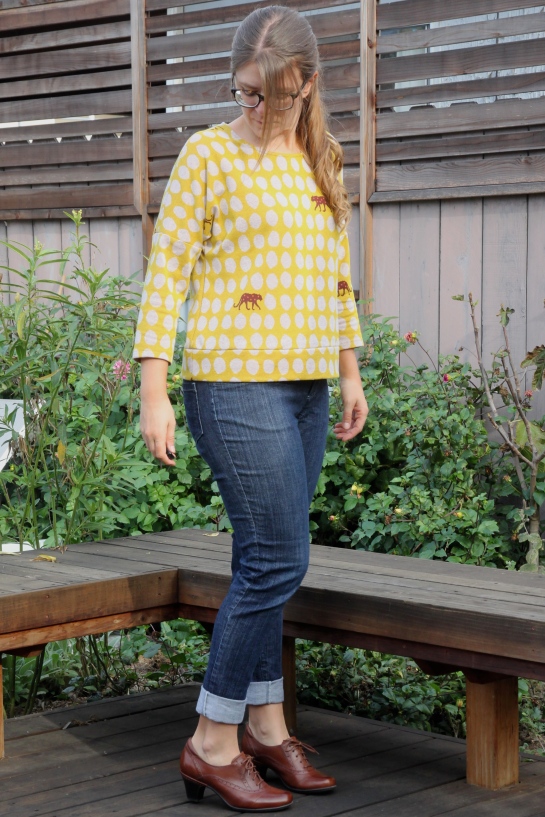Well hello. Apparently I have a blog. Wouldn’t have known, for all the attention I’ve paid to it lately. No crazy(ier than usual) life stuff, just a matter of wanting recently to spend my free time either sewing or vegging, of which blogging is neither. But. Here it is, fall somehow, so I suppose I should wrap up summer with the pattern I spent the summer making. My 2016 summer pattern obsession: the Hey June Santa Fe top.
I knew instantly when this pattern was released that it was for me. Given last summer’s obsession with the Tessuti Ruby (and that hasn’t gone away either, I also made three more of those this year), a swing top with more options seemed the logical next step. However, I somehow had zero drapey rayon knits in my stash. How that’s even possible I have no idea, but when I went eagerly hunting in the fabric closet for Santa Fe candidates I came up disappointed. So obviously I channeled that disappointment into fabric shopping. I discovered LA Finch Fabrics, which seems to be the internet version of roaming through the LA fashion district. It seemed rather silly to have them do it for me when I could just drive down there and hunt myself, but on the other hand, if they do it for me I don’t have to drive down there and hunt myself. Fun print rayons were soon making their way up the 101 to me, and were washed and turned into tanks immediately.
Some overall notes on the pattern: I made a straight size medium for all versions. Generally I would grade out to a larger size in the waist/hip, but I skipped that because of the swingy shape, so it’s probably less swingy on me than intended. I do love the shape and the length is right – shorter than the Ruby, but it’s wider too so that makes sense. I omitted the front/back seam on all my versions because I thought it was unnecessary and just asking for wavy seam weirdness. I was also able to fit all of the versions onto just a yard of wide knit fabric. And I made all these tops in just a couple hours each from start to finish. So pretty much the perfect summer top. My only quibble is with the binding – specifics below.
 My first Santa Fe was the cut-in tank with contrast (view D). I happened to have a bit of leftover pink knit from my Pneuma Tank that matched this Finch flamingo print perfectly. I love this top, except that I can’t wear it with my favorite shorts, which are also gray. When that’s the only thing wrong with a top you know you’ve found a winner.
My first Santa Fe was the cut-in tank with contrast (view D). I happened to have a bit of leftover pink knit from my Pneuma Tank that matched this Finch flamingo print perfectly. I love this top, except that I can’t wear it with my favorite shorts, which are also gray. When that’s the only thing wrong with a top you know you’ve found a winner.
On this version I used the instructed binding method, which I have to say I don’t like very much. It’s the attach-to-wrong-side-flip-to-right-side-around-edge-and-topstitch method, which for some reason I find more fiddly and annoying the the reverse method of turning to the inside and stitching in the ditch. But I vastly prefer bands as a knit finish to either kind of binding anyway – much faster, easier, and any imperfect stitching is less obvious. But for some reason I stuck with the binding.
 My next tank was the plain cut-in version (view A), minus center seam. The fabric is a great feather print, but it’s not a high quality rayon and it’s already showing wear. It’s a printed knit, so it shows through white when it’s stretched, which means if you look closely you can see some white in the bindings. (It was after this top that I abandoned the binding method entirely.) Also, after washing a couple times I noticed that the tank has become decidedly asymmetrical. On closer inspection it seems to be terribly off grain, which I suppose is my fault – the fabric must have been off grain but I didn’t notice and folded it as usual. Although on my next two tops, before hemming I laid them out flat and the hem was slightly asymmetrical for some reason, so I trimmed it even and have had no problems, but I’m not sure why that’s happening. I should un-hem the feather tank, trim it, and re-hem, but I haven’t wanted to take the time.
My next tank was the plain cut-in version (view A), minus center seam. The fabric is a great feather print, but it’s not a high quality rayon and it’s already showing wear. It’s a printed knit, so it shows through white when it’s stretched, which means if you look closely you can see some white in the bindings. (It was after this top that I abandoned the binding method entirely.) Also, after washing a couple times I noticed that the tank has become decidedly asymmetrical. On closer inspection it seems to be terribly off grain, which I suppose is my fault – the fabric must have been off grain but I didn’t notice and folded it as usual. Although on my next two tops, before hemming I laid them out flat and the hem was slightly asymmetrical for some reason, so I trimmed it even and have had no problems, but I’m not sure why that’s happening. I should un-hem the feather tank, trim it, and re-hem, but I haven’t wanted to take the time.
In July, armed with both tanks, I went on a trip to the Bay Area, and managed to fit in a stop at Stonemountain and Daughter in Berkeley on my way home because I badly wanted more drapey fabrics for Santa Fes. I was remarkably restrained in that I only bought two pieces and sewed them both up immediately.
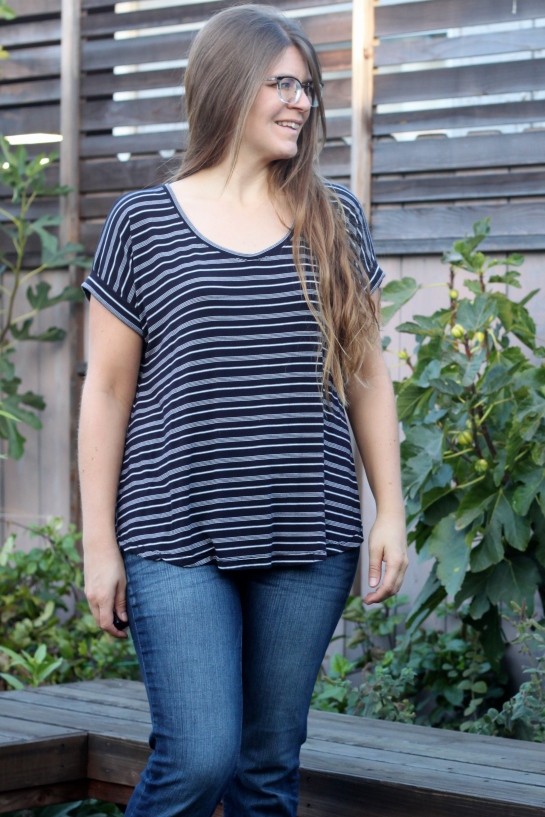 The first was this gorgeous black and white stripe rayon that I made into the plain sleeved version (view C), again sans center seam. I loved the testers’ striped versions with the dolman sleeves creating a vertical stripe that gets cut by the horizontal stripe of the cuff, and I had to have that. The cuff is actually a nice design feature that dresses up the top a little, I think. And I decided to finish the neckline of this version with a band rather than a binding. To preserve the intended neckline opening I trimmed the seam allowance off of the neckline, since I would be adding it back with the band, and for the band length I used 80% of the neckline measurement because my knit was incredibly stretchy. It worked out, though I think the neckline is very slightly bigger than I’d like.
The first was this gorgeous black and white stripe rayon that I made into the plain sleeved version (view C), again sans center seam. I loved the testers’ striped versions with the dolman sleeves creating a vertical stripe that gets cut by the horizontal stripe of the cuff, and I had to have that. The cuff is actually a nice design feature that dresses up the top a little, I think. And I decided to finish the neckline of this version with a band rather than a binding. To preserve the intended neckline opening I trimmed the seam allowance off of the neckline, since I would be adding it back with the band, and for the band length I used 80% of the neckline measurement because my knit was incredibly stretchy. It worked out, though I think the neckline is very slightly bigger than I’d like.
 And for my last version, I thought I’d do some stripe play with this great purple and gray bamboo jersey, so I made view F with the contrast sleeves, cutting the sleeves on the cross grain. This knit is super stretchy in all directions, so I knew it’d work to flip the shoulder pieces (though it was a real brain bender in the moment, and I was barely able to fit it into my yard of fabric). I finished the neckline with a band again, but this time I didn’t trim the neckline first. And because I didn’t want to go overboard with the stripe swapping, I omitted the cuff and just hemmed the sleeves.
And for my last version, I thought I’d do some stripe play with this great purple and gray bamboo jersey, so I made view F with the contrast sleeves, cutting the sleeves on the cross grain. This knit is super stretchy in all directions, so I knew it’d work to flip the shoulder pieces (though it was a real brain bender in the moment, and I was barely able to fit it into my yard of fabric). I finished the neckline with a band again, but this time I didn’t trim the neckline first. And because I didn’t want to go overboard with the stripe swapping, I omitted the cuff and just hemmed the sleeves.
So there it is, the shirt of summer. Of course, I did make more than this over the last few months, as you may have seen if you follow me on instagram. I didn’t want to be one of those people who abandon their blog for instagram, since I’ve always been more of a words person than a picture person and the lack of details on instagram drives me a little batty, but I do think that I would have abandoned the blog regardless of if I had another outlet to share on, so I can’t blame instagram entirely. I have much more to say about many of the things I posted there over the summer, so hopefully I can manage to give them a proper write up before we’re all totally buried in pumpkin everything and cozy cowls and wool coats and all that.
P.S. Runner-up pattern of the summer: Grainline’s Driftless Cardigan. Our summers are never particularly warm (until October anyway), so I got a ton of use out of the three (yes, three!) Driftlesses I made. Plus I just finished a fourth in merino for the fall I’m sure we’ll get in December. It’s a great pattern. Goes well with a Santa Fe, or four. Ask me how I know.
















 Back piece done, I constructed the jersey as instructed. To attach the zipper, I tried
Back piece done, I constructed the jersey as instructed. To attach the zipper, I tried 




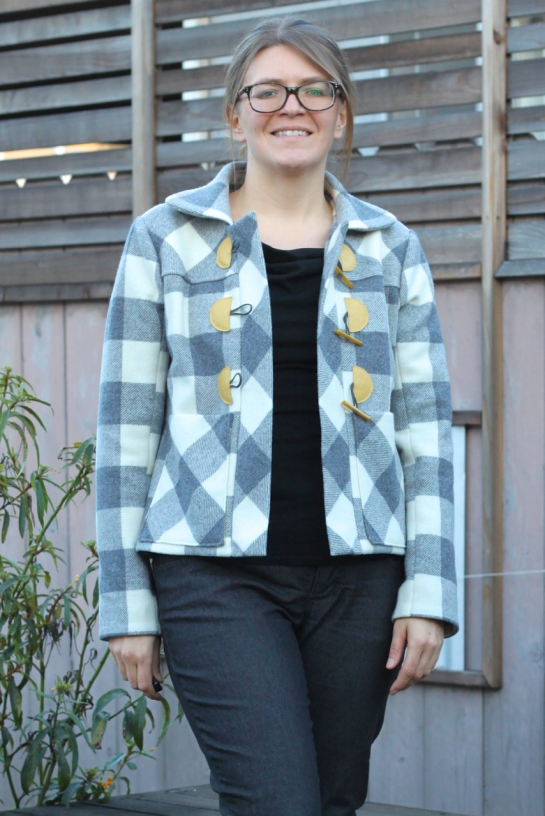


 I had never bagged a lining before, but I’d read a million tutorials for it, and while they didn’t make a ton of sense out of context, as soon as I had the actual coat before me, the method became very clear. In general I found the
I had never bagged a lining before, but I’d read a million tutorials for it, and while they didn’t make a ton of sense out of context, as soon as I had the actual coat before me, the method became very clear. In general I found the  I appreciate that this pattern seems much more accessible than a traditional Big 5 tailored coat pattern, and it doesn’t seem to require all the complicated hair interfacing and padstitching and rolled lapels etc that I’ve read about and been intimidated by all over the internet for the last several years. I think this coat is a perfect intro to wool coat sewing. The collar was straightforward, it doesn’t require sleeve heads or shoulder pads, and no buttonholes, bound or otherwise. For me, I don’t know that it’ll lead to more complicated coats, just because as a Californian I have little need for wool coats, and I already have like 4 RTW ones, but I could see the Cascade being a gateway coat for others more inclined to wool-wearing. I could, however, see myself making another version in a lighter, more casual fabric, if the duffle coat trend continues. But… probably not anytime soon. I’m just gonna savor my victory for a little bit.
I appreciate that this pattern seems much more accessible than a traditional Big 5 tailored coat pattern, and it doesn’t seem to require all the complicated hair interfacing and padstitching and rolled lapels etc that I’ve read about and been intimidated by all over the internet for the last several years. I think this coat is a perfect intro to wool coat sewing. The collar was straightforward, it doesn’t require sleeve heads or shoulder pads, and no buttonholes, bound or otherwise. For me, I don’t know that it’ll lead to more complicated coats, just because as a Californian I have little need for wool coats, and I already have like 4 RTW ones, but I could see the Cascade being a gateway coat for others more inclined to wool-wearing. I could, however, see myself making another version in a lighter, more casual fabric, if the duffle coat trend continues. But… probably not anytime soon. I’m just gonna savor my victory for a little bit.


